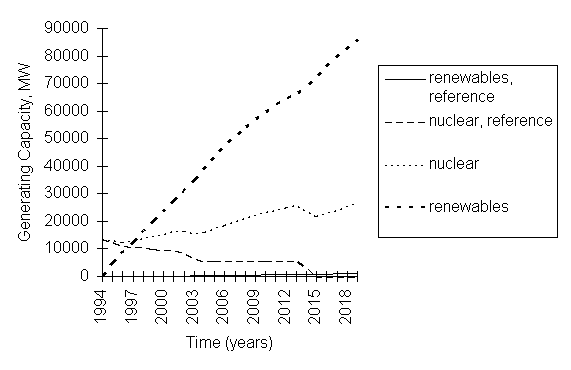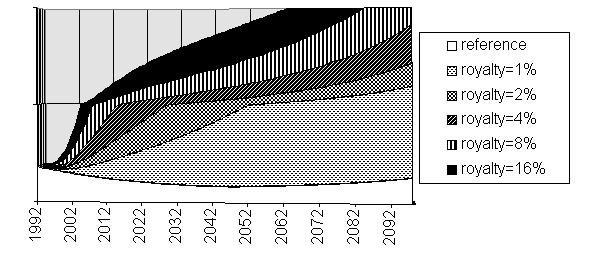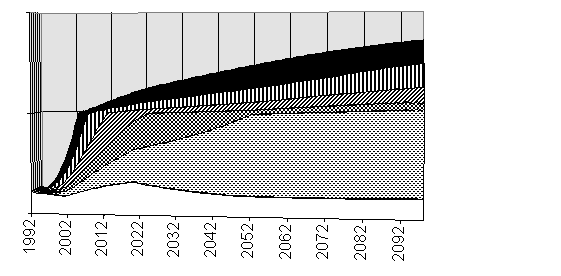
Can renewable energy fuel the world?
?
An input to the INES conference at Stockholm June 2000: Workshop C3
by Malcolm Slesser
Can renewable energy fuel the world? On the face of it this is ridiculous question. Does not the sun beams down upon Earth a solar flux of 178 billion kilowatts, about ten thousand times the current rate of energy consumption? Indeed it does, but the problem is that this solar flux is dilute, at best about one kilowatt per square metre, and then only at midday in the Sahara desert. This is not the only issue. We have built a civilisation based on ready access to concentrated energy forms like petroleum, coal and natural gas. Though to replicate these through the medium of a dilute solar flux is unquestionably possible from a technological aspect, it takes a fair bit of physical capital to implement, not to mention large areas of ground. Furthermore, it is not heat that we need in large measure, but thermodynamic work, for this is what propels vehicles, and transforms ores into metals, and performs a host of other vital roles, such as purifying water for drinking or making nitrogen fertilisers. The step from solar heat to work is the crux of the matter.
The zealot will respond that we need not go that route. We must build a new infrastructure based on renewables coupled to a different lifestyle. When one looks at any large city or the thousands of vehicles whizzing down an autoroute one has to ask oneself how such a lifestyle transformation can occur. Is there, instead, a technological solution?
This writer shares the desire to see a world run by renewable energy, where the dissipation of nitrogen oxides, sulphur dioxide and carbon dioxide are things of the past. Where there is no need for men to work thousands of feet below ground digging out coal, or where off-shore oil exploration and nuclear energy with its attendant pollution risks can be abandoned. But is it possible to achieve this state of grace? Or, putting it another, way can we achieve it before the fossil fuels run out? Greenpeace apparently is in no doubt. It is assured by the Stockholm Environment Institute that we need no more exploration of off-shore oil. [Richard - have I got this right?]. That a transition to a renewable-driven economy can be made now if we have the will. I wish I could agree, but I cannot. Let me explain.
If one wants to look to the future in which one resource and its associated technology is to be replaced by another, then there are two ways of checking it out. The usual approach is to put monetary values on the alternatives, such as assuming that electricity from large scale wind-driven generators will produce electricity at 1.6 pence per kilowatt hour, and which with anticipated technological advance may be expected to cost less as we climb onto the learning curve. These monetary values are compared to estimates of future prices of the fossil and fissile fuels that dominate our current energy supply system. I have to say that this is little more than a guessing game, the more so as these analyses are projected further into the future.
Another, more robust way, is to pose the following question. How much energy is needed to build a solar capture device, which when up and running will replace the requirements currently met by fossil or fissile technology. Many will recognise this as having the elements of an energy pay-back calculation. But the analysis has to go a little further. The energy invested finishes up in the form of manufactured, that is human-made, capital (HMC). This is in turn is the product of a manufacturing system, currently wedded to fossil and fissile energy technologies. As penetration of the renewable technology proceeds, there will come a time when the solar capture devices (which are also HMC) have to be made from the captured solar energy, available as high quality energy, that is as thermodynamic work. At this stage we have a solar breeder, but not yet a sustainable state, for the penetration must eventually be one hundred percent.
?
To establish how long or how fast we can effect this transition cannot be computed on the back of an envelope; it needs a dynamic model of the world economy expressed in physical terms. Such models are known as Natural Capital Accounting models. We use the application of this principle under the name ECCO (Evolution of Capital Creation Options). It is a holistic model of the economy which simulates its evolution in the context of user-imposed environmental constraints, user-defined social objectives and user-defined production and energy technologies. Such models determine the maximum growth rate possible of the economy under the imposed conditions. We can use such a model to explore a deliberate transition from fossil and fissile technologies to renewables. This can even be explored under market forces if there is enough data to hand to work out the marginal energy requirement for traditional and new sources, but the results are not encouraging!
?
Data, as well as the model, are the key to the analysis. The hard facts are that megawatt for megawatt renewable energy technologies which can deliver thermodynamic work require the investment of much the same amount of high quality energy as nuclear-driven generators, and much more than fossil driven system. But there is worse news to come. The load factor of solar energy systems are much lower than those of nuclear or fossil, so that the system capacity, and hence physical investment (which means energy investment) is that much larger for a renewable system. Table 1 below gives some feeling for the differences. Figure 1 compares the required capacity of a Business-as-usual United Kingdom economy with a fast track renewables policy (This is figure 8.2 in our book 'The Management of Greed').
?
?
Table 1: Output per unit investment of various electricity generators compared to gas-fired (combined cycle gas turbine) generators, which have the lowest investment cost of any current system
| Technology of generation | Load factor |
Output per unit investment
CCGT = 100 |
|
Gas-fired combined cycle
gas turbine (CCGT) |
typically 80% | 100 |
|
Nuclear: pressured water
reactor |
typically 70% | 50 |
| Coal-fired | typically 80% | 90 |
| Wind-power | 23% (windy regime) | 30 |
| Photo-voltaic | 18% (cloudy climate) | 6 |
?
?

Figure 1: Required UK electrical generating capacities under the two scenarios
?
We also found that the renewables scenario took its toll of material standard of living, which scarcely rose over 20 years. Looking further ahead we were forced to conclude that a fully fossil-replacement UK could only be achieved with the help of nuclear power- the UK has a very high population density. We also found that though the renewables strategy prevented the growth of fossil-fuel consumption, it actually failed to cut it back significantly as the economy continued to grow. This is one reason why I have to disagree with Greenpace in its efforts to curb exploration for oil west of Shetland. We are going to need that oil simply to build the replacements.
?
Hydrogen economy
Amongst the most effective renewable technologies are photo-voltaics and wind-driven generators. They produce electricity directly, which is work in the thermodynamic sense. From electricity one can produce hydrogen, and so to fuel-cells for vehicle transportation. The basis of a global renewable strategy almost certainly has to come via what is often called the 'hydrogen economy'. We examined the potential for such an economy at the global level in the following way. Suppose a certain fraction of fossil energy consumption is always diverted to building a renewable-sourced energy supply, initially by replacing fossil and fissile generated electricity, and then when that had been achieved, by expanding the investment and using the electricity to make hydrogen as the basis of a new fuel source, whether directly or by its transformation to liquid fuels with carbon. What percentage should that be? In 1992, globally, just under 1% of fossil fuel consumption was used to maintain and expand the world's electricity production system (not the fuel to run it, but the fuel to build it). So we explored 1%, 2%, 4%, 8% and 16%. We used a mix of 51% photo-voltaic, 9% wind, and 40% nuclear to replace the fossil sources.
As one would expect, the higher the royalty, the more rapid is the move towards a physically sustainable energy supply. Royalties of 8% and 16% even manage a full substitution by hydrogen in the developed world within the time-frame of our study (105 years) but at a huge cost to the material standard of living. Figures 2a and 2b show the penetration. Since few of us will live a full century, it is interesting to ask what social and economic price does the current and immediately following generation have to pay to secure a sustainable future for more distant generations?
 (a)
(a)
?
?
?

(b)
?
Figure 2: Penetration of the hydrogen economy depicted as the percentage of electricity produced by non-fossil sources under different "royalty" options. (a) developed world (b) developing world
?
In terms of industrial development the price is not paid till the programme has been going for about fifty years. At that point the annual replacement investment becomes very high, and as a result industrial output falls. Note however that in this scenario we have attempted to maintain all existing social welfare and domestic standards which may be quite unrealistic. Figure 3 shows the effect on the average material affluence for the developed world, which in every case broadly climbs to a peak in about 75 year's time, and then, for the same reason as given above, is eroded.
Figure 3 Material affluence index for the developed world under the hydrogen economy for various "royalties"
?
The outlook for the developing world is less encouraging, for the demands of investment in renewables saps the ability of the developing world to expand its industrial economy, thus though significant replacement takes place, it is at the expense of a loss of growth. Nonetheless progress is made and both industrial development and material affluence continue to rise throughout the century to 2100 Indeed in relative terms the gains are greater, material standard of living being 400% higher in 2100 with a 4% royalty - the optimum proportion.
Comment
To answer question posed at the outset 'Can renewable energy fuel the world?' the answer is probably yes, but the time horizon is of the order of a century or more. In the meantime we shall need all the oil and gas we can lay our hands on to keep the system going and build the renewable replacements. Moreover for a full hydrogen economy we shall need coal as a carbon source for some uses where portable liquid fuels are essential.
?
A justifiable criticism of the study reported above is that the input data may be inaccurate or out of date; that the policies proposed are not the best; and that no alternative life-styles have been explored, such putting up with a reduced material standard of living. And, of course, the model may be structurally inadequate.
Our over-riding concern is to get over the message that looking at such a major transformations in the economy as switching from fossil and fissile fuels to renewables requires that the issue be looked at in physical terms not monetary. GlobEcco, which was the basis of the global study is in the public domain. Anyone who wishes to send me a 3.5 inch floppy disk and prepaid envelope is welcome to the programme. UKECCO is likewise freely available, and we are currently working on a version which can be manipulated on-line.
?
The team that worked on these models is no longer funded. It is our hope that others will take off from where we have left off.
A fuller description of this work is in chapter 8 of our book The Management of Greed, David Crane, Jane King & Malcolm Slesser (1997) ISBN 1-872579-07 8.